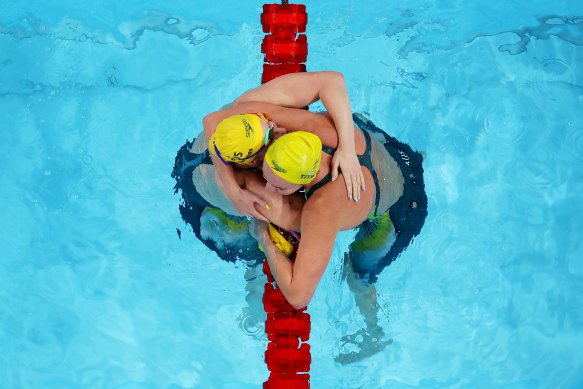The science behind why Paris’ ‘slow pool’ is affecting our swimmers
By Liam Mannix
Mollie O’Callaghan looked as shocked as anyone else at La Defense Arena. She peeled off her cap, bright yellow against the blue water, shook her head, and then shook it again, as if not quite believing what the scoreboard told her.
O’Callaghan had just won her first Olympic gold, edging out Australian friend, teammate and rival Ariarne Titmus by a fraction of a second across the 200 metres of the women’s freestyle final on Tuesday morning.
“We are competitors and we’re also teammates. It’s really tough. We both push each other to the limits,” O’Callaghan told Channel Nine afterwards.

Mollie O’Callaghan and Ariarne Titmus hug after the final of the women’s 200m freestyle.Credit: Getty Images
Except that’s not quite true in Paris.
We expect the Olympics to bring out the best in our athletes. They tailor their training over years to peak at the competition.
But after five days of competition at La Defense, only a single world record has been set. Many winning times have fallen well short of those seen in other Olympics.
O’Callaghan’s and Titmus’ race is the best example. The former set the women’s 200m freestyle world record in 2023 with a time of 1:52.85, before Titmus beat that by 0.62 seconds at a meeting in June.
Both women swam well outside that time on Tuesday. O’Callaghan swam 1:53.27 and Titmus 1:53.81 – almost a second slower than her own world record.
What explains the slower swims? In a sport decided by fractions of a second, the simplest answer is … chance.
Analysis by researchers at Queensland University of Technology’s Centre for Data Science, based on athlete performance and trends from past Olympics, found the swimmers were mostly “within half a percentage point of predicted time”.
But others point to something below the water line: the unusually shallow pool at La Defense.
Fluid dynamics
Under international regulations, Olympic swimming pools must be at least 2.5 metres deep. La Defense’s temporary pool is just 2.1 metres deep, and its floor is pockmarked with underwater cameras and lap-counting screens.
As swimmers move through the water they push waves ahead and below them. The waves travel along or down until they hit a wall or the floor, and then rebound.
In a shallower pool, the wave will hit the bottom earlier and rebound with more energy, eventually disturbing the water at the top of the pool. With each swimmer generating multiple waves that collide, the top of the pool quickly becomes a turbulent mess, says Brendan Burkett, a professor of high performance sport at the University of the Sunshine Coast.
Burkett can speak from personal experience; before he became a researcher, he was a Paralympian who once held the 50m freestyle world record. Turbulent water is “rougher. It feels thicker and heavier, because you’ve got more resistance,” he says. “All these little things count when you’re trying to be the best in the world.”
University of NSW Associate Professor Fang-Bao Tian has collaborated with the Australian Institute of Sport on studies of drag on swimmers and cyclists. The turbulence effect from a shallow pool is tiny, he says. “But these are high-performance athletes. Even though these changes may be half a per cent, that may affect the outcome.”
Of course, everyone is swimming in the same pool – so does it really matter? Burkett says a choppier pool “creates a slight advantage” for a more technical athlete, who will be less affected than one relying on strength and stamina.
“All those little things contribute to more effort, which means you’re not getting a world record performance.”
Get the day’s breaking news, entertainment ideas and a long read to enjoy. Sign up to receive our Evening Edition newsletter here.